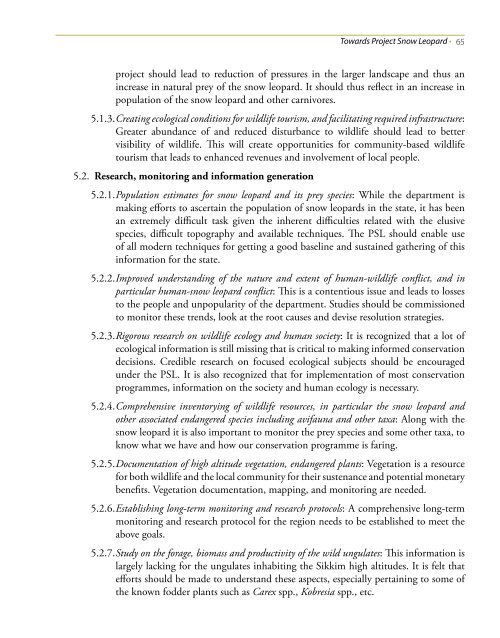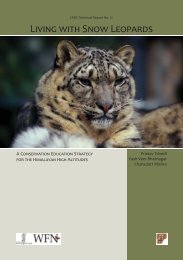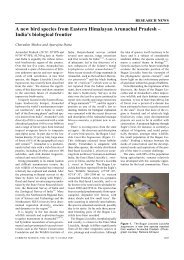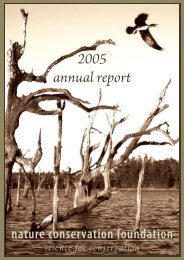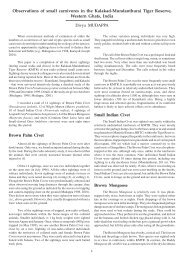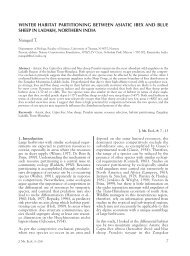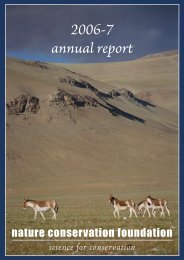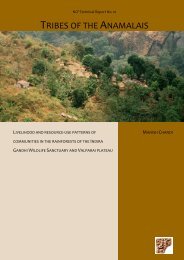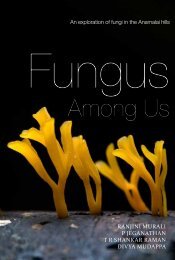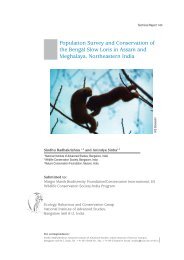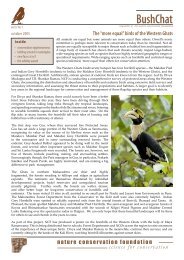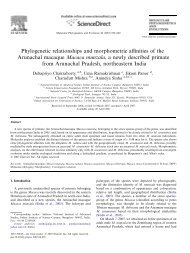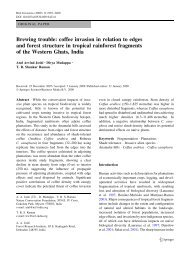towards project snow leopard - Nature Conservation Foundation
towards project snow leopard - Nature Conservation Foundation
towards project snow leopard - Nature Conservation Foundation
You also want an ePaper? Increase the reach of your titles
YUMPU automatically turns print PDFs into web optimized ePapers that Google loves.
Towards Project Snow Leopard • 65<br />
<strong>project</strong> should lead to reduction of pressures in the larger landscape and thus an<br />
increase in natural prey of the <strong>snow</strong> <strong>leopard</strong>. It should thus reflect in an increase in<br />
population of the <strong>snow</strong> <strong>leopard</strong> and other carnivores.<br />
5.1.3. Creating ecological conditions for wildlife tourism, and facilitating required infrastructure:<br />
Greater abundance of and reduced disturbance to wildlife should lead to better<br />
visibility of wildlife. This will create opportunities for community-based wildlife<br />
tourism that leads to enhanced revenues and involvement of local people.<br />
5.2. Research, monitoring and information generation<br />
5.2.1. Population estimates for <strong>snow</strong> <strong>leopard</strong> and its prey species: While the department is<br />
making efforts to ascertain the population of <strong>snow</strong> <strong>leopard</strong>s in the state, it has been<br />
an extremely difficult task given the inherent difficulties related with the elusive<br />
species, difficult topography and available techniques. The PSL should enable use<br />
of all modern techniques for getting a good baseline and sustained gathering of this<br />
information for the state.<br />
5.2.2. Improved understanding of the nature and extent of human-wildlife conflict, and in<br />
particular human-<strong>snow</strong> <strong>leopard</strong> conflict: This is a contentious issue and leads to losses<br />
to the people and unpopularity of the department. Studies should be commissioned<br />
to monitor these trends, look at the root causes and devise resolution strategies.<br />
5.2.3. Rigorous research on wildlife ecology and human society: It is recognized that a lot of<br />
ecological information is still missing that is critical to making informed conservation<br />
decisions. Credible research on focused ecological subjects should be encouraged<br />
under the PSL. It is also recognized that for implementation of most conservation<br />
programmes, information on the society and human ecology is necessary.<br />
5.2.4. Comprehensive inventorying of wildlife resources, in particular the <strong>snow</strong> <strong>leopard</strong> and<br />
other associated endangered species including avifauna and other taxa: Along with the<br />
<strong>snow</strong> <strong>leopard</strong> it is also important to monitor the prey species and some other taxa, to<br />
know what we have and how our conservation programme is faring.<br />
5.2.5. Documentation of high altitude vegetation, endangered plants: Vegetation is a resource<br />
for both wildlife and the local community for their sustenance and potential monetary<br />
benefits. Vegetation documentation, mapping, and monitoring are needed.<br />
5.2.6. Establishing long-term monitoring and research protocols: A comprehensive long-term<br />
monitoring and research protocol for the region needs to be established to meet the<br />
above goals.<br />
5.2.7. Study on the forage, biomass and productivity of the wild ungulates: This information is<br />
largely lacking for the ungulates inhabiting the Sikkim high altitudes. It is felt that<br />
efforts should be made to understand these aspects, especially pertaining to some of<br />
the known fodder plants such as Carex spp., Kobresia spp., etc.


